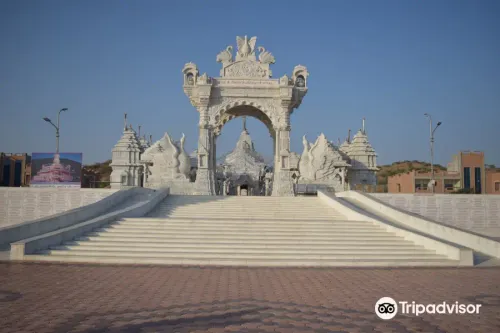
Chintamani Parasnath Jain Temple: A Testament to Jain Devotion
Chintamani Parasnath Jain Temple, located in Barmer, Rajasthan, is an important religious site dedicated to Parasnath, the 23rd Tirthankara in Jainism. This temple holds significant spiritual, historical, and cultural value, reflecting the rich traditions and architectural elegance of Jainism in the region.
Location and Historical Context
- Location: Barmer, Rajasthan, India
- Historical Context: Barmer, situated in the western part of Rajasthan, is known for its historical significance and cultural heritage. The Chintamani Parasnath Jain Temple adds to this rich tapestry by serving as a key religious and historical landmark. The temple is part of the broader history of Jainism in Rajasthan, a region known for its deep-rooted Jain traditions and architectural marvels.
Architectural and Design Features
1. Architectural Style
Traditional Jain Architecture: The Chintamani Parasnath Jain Temple exemplifies traditional Jain architectural style, characterized by intricate carvings, detailed sculptures, and a well-planned layout. Jain temples are renowned for their artistic detail and spiritual symbolism, and this temple is a prime example of these elements.
Materials: Constructed primarily of marble, the temple features the high-quality materials typical of Jain temples. The use of marble enhances the temple’s aesthetic appeal and durability.
2. Main Shrine
Deity Representation: The temple is dedicated to Parasnath, the 23rd Tirthankara. The central shrine houses a revered idol of Parasnath in a meditative pose, symbolizing tranquility and spiritual enlightenment. The idol is adorned with traditional decorations that reflect the divine attributes associated with the Tirthankara.
Intricate Carvings: The temple’s architecture includes elaborate carvings and sculptures depicting various Jain deities, mythological stories, and geometric patterns. These carvings contribute to the spiritual ambiance of the temple and highlight the artistic skill of its builders.
3. Temple Complex
Prayer Hall: The temple features a spacious prayer hall designed to accommodate devotees and visitors. The hall is a focal point for worship, meditation, and religious ceremonies.
Surrounding Environment: The temple is set in a tranquil environment that complements its spiritual significance. The peaceful surroundings enhance the devotional experience and provide a serene space for contemplation.
Cultural and Spiritual Significance
1. Spiritual Hub
Devotional Practices: The Chintamani Parasnath Jain Temple serves as a central place for worshiping Parasnath. Devotees visit the temple to offer prayers, seek blessings, and participate in Jain rituals and ceremonies. The temple plays a crucial role in the spiritual life of the Jain community in Barmer.
Festivals and Ceremonies: Key Jain festivals such as Paryushana, Mahavir Jayanti, and Diwali are celebrated with special ceremonies at the temple. These events include devotional services, processions, and community activities that attract both local and visiting devotees.
2. Historical Importance
Cultural Heritage: The temple is an important part of Barmer’s cultural and religious heritage. Its architectural style and historical significance reflect the deep traditions of Jainism in Rajasthan and contribute to the region’s historical narrative.
Preservation of Tradition: The Chintamani Parasnath Jain Temple plays a vital role in preserving Jain customs and practices. It serves as a historical landmark that continues to engage the local Jain community and visitors in religious and cultural activities.
Visiting Chintamani Parasnath Jain Temple
1. Planning Your Visit
Timings: The temple is generally open throughout the day, with specific timings for prayers and rituals. It is advisable to check the temple’s schedule, especially during major festivals or special events, before planning your visit.
Entry Guidelines: Visitors should dress modestly and follow the temple’s guidelines. Jain temples emphasize respect and purity, so maintaining a respectful demeanor is essential.
Local Customs: Engaging in local customs, such as participating in rituals and respecting the temple’s sacred space, will enhance your experience and show appreciation for Jain traditions.
2. Exploring the Temple Complex
Photography: Photography inside the temple may be restricted, particularly in the main shrine area. It is advisable to seek permission before taking any photographs and to follow the temple’s guidelines.
Nearby Attractions: While visiting the Chintamani Parasnath Jain Temple, consider exploring other attractions in Barmer, such as the Barmer Fort, Kiradu Temples, and local markets. These sites offer additional insights into the region’s history and culture.
Experience Spiritual Harmony
The Chintamani Parasnath Jain Temple in Barmer offers a deep spiritual and historical experience, combining the beauty of Jain architecture with profound religious significance. Its serene environment, cultural importance, and dedication to traditional practices make it a significant destination for spiritual seekers and history enthusiasts alike.
Immerse yourself in the tranquil atmosphere of Chintamani Parasnath Jain Temple, where architectural grace and spiritual heritage meet. Let the temple’s serene setting and rich cultural traditions enhance your visit to Barmer and provide a greater appreciation of Jain spirituality and architectural excellence.
